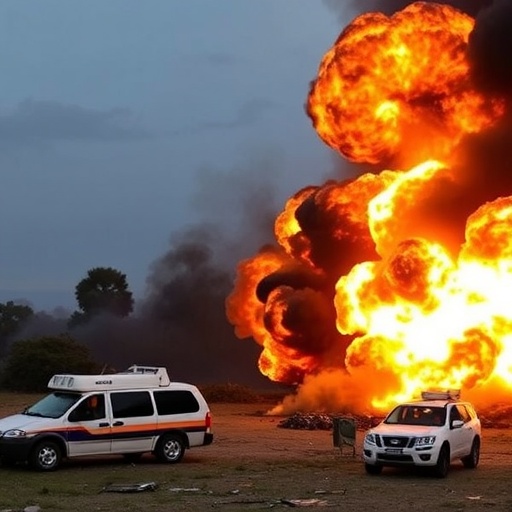Trump Administration Ramps Up War on Drugs: Ninth Military Strike Targets Pacific Smugglers, 37 Dead in Escalating Campaign
In a bold escalation of the war on drugs, the U.S. military under President Trump‘s administration launched its ninth military strike this week against suspected drug cartels‘ vessels in the Pacific Ocean, sinking a high-speed go-fast boat loaded with narcotics just 50 miles off Mexico’s western coast. The operation, part of a intensified campaign that began last month, has already claimed at least 37 lives, including cartel operatives and several crew members caught in the crossfire, according to Pentagon officials. This aggressive posture signals a dramatic shift, treating narco-traffickers not as criminals, but as enemy combatants akin to terrorist groups.
- Ninth Strike Unfolds in High-Seas Chase Off Baja California
- Hegseth’s Al Qaeda Analogy Signals New Era in War on Drugs
- Cartel Networks Reel from Intensified U.S. Military Pressure
- Human Toll Mounts as Strikes Spark Ethical and Diplomatic Concerns
- Looking Ahead: Sustaining Momentum in the Pacific Drug War
The strike occurred early Wednesday morning when U.S. Navy destroyers from the USS Abraham Lincoln carrier strike group intercepted the vessel after intelligence from the Joint Interagency Task Force South pinpointed its location. Flares lit up the night sky as warning shots were fired, but the smugglers’ attempt to flee ended in a hail of precision gunfire and a subsequent boarding action that left the boat in flames. Over 2 tons of cocaine were recovered from the wreckage, valued at more than $60 million on the street.
Defense Secretary Pete Hegseth, a staunch Trump ally and former Fox News commentator, addressed reporters from the Pentagon, declaring, “These drug cartels are no longer just thugs peddling poison—they’re waging war on America. We’ll treat them like Al Qaeda: hunt them down, disrupt their networks, and eliminate the threat wherever it hides in the Pacific Ocean or beyond.” Hegseth’s rhetoric underscores the administration’s zero-tolerance approach, which has drawn both praise from law enforcement hawks and sharp criticism from human rights advocates concerned about the mounting casualties.
Ninth Strike Unfolds in High-Seas Chase Off Baja California
The latest military strike exemplifies the high-stakes cat-and-mouse game playing out in the vast expanse of the Pacific Ocean. According to a detailed briefing released by U.S. Southern Command (SOUTHCOM), the targeted vessel was a 40-foot fiberglass craft equipped with multiple outboard engines, a hallmark of drug cartels‘ smuggling operations run by groups like the Sinaloa and Jalisco New Generation cartels. These “go-fast” boats can reach speeds exceeding 50 knots, making them elusive prey for pursuing naval forces.
Intelligence gathering began days earlier when U.S. Coast Guard P-8 Poseidon aircraft spotted suspicious activity near Baja California. Drone surveillance confirmed the boat’s cargo, and by dawn, two Arleigh Burke-class destroyers closed in. “The crew ignored all hails and attempted to jettison their load,” said Rear Adm. Lisa Franchetti, commander of the strike group. “We had no choice but to neutralize the threat to prevent the drugs from reaching American shores.”
Video footage released by the Navy shows the dramatic sequence: helicopter spotlights piercing the darkness, followed by bursts from .50-caliber machine guns that shredded the boat’s engines. Four individuals were killed in the exchange, with two more perishing when the vessel capsized. Survivors were detained and are being held at a U.S. naval base in San Diego for questioning. This marks the second such interception in the Gulf of California this week, highlighting the concentrated focus on this smuggling hotspot.
Since President Trump took office earlier this year, interdiction efforts have surged. SOUTHCOM reports that maritime seizures in the Pacific Ocean have jumped 45% compared to the previous administration, with over 150 tons of cocaine confiscated in the first quarter alone. However, the operations aren’t without risks—last week’s strike saw a U.S. helicopter take fire from a cartel speedboat, injuring two sailors in a rare direct confrontation.
Hegseth’s Al Qaeda Analogy Signals New Era in War on Drugs
Defense Secretary Hegseth’s comparison of drug cartels to Al Qaeda has ignited fierce debate in Washington and beyond, framing the war on drugs as a national security imperative rather than a law enforcement issue. In a fiery speech at the Heritage Foundation, Hegseth outlined the administration’s doctrine: “Just as we pursued bin Laden across mountains and deserts, we’ll chase these cartels across oceans and borders. No safe havens, no mercy for those poisoning our communities.”
This rhetoric builds on Trump‘s long-standing tough-on-crime stance, echoed in his first term when he deployed National Guard troops to the border. Now, with military assets fully engaged, the strategy involves expanded rules of engagement for naval forces. Previously, U.S. vessels could only pursue and board if drugs were visible; under the new policy, suspicion alone—backed by intelligence—warrants action.
Experts like Vanda Felbab-Brown from the Brookings Institution praise the shift for its potential impact. “Treating cartels as hybrid threats allows for more proactive measures,” she said in an interview. “The Pacific Ocean routes are vital arteries for fentanyl and meth precursors; disrupting them could save thousands of American lives lost to overdoses.” The opioid crisis, which claimed over 100,000 lives in 2023, provides stark motivation—fentanyl alone, largely sourced from Mexican labs and shipped via sea, fuels 70% of fatal overdoses.
Yet, not all voices are supportive. The ACLU has filed a lawsuit challenging the expanded military role, arguing it blurs lines between defense and policing. “This is a recipe for overreach and civilian casualties,” said ACLU counsel Lee Gelernt. International relations are strained too; Mexico’s President Claudia Sheinbaum issued a statement condemning the strikes as “unilateral aggression,” though privately, sources say cooperation has quietly increased through backchannel talks.
Cartel Networks Reel from Intensified U.S. Military Pressure
The military strikes are hitting drug cartels where it hurts most: their maritime supply lines. The Sinaloa Cartel, once led by Joaquín “El Chapo” Guzmán, has reportedly lost millions in seized shipments and key operatives. A leaked DEA report estimates that Pacific routes account for 60% of cocaine flows to the U.S. West Coast, with submarines and semi-submersibles joining traditional boats in evading detection.
In response, cartels are adapting. Intercepted communications reveal plans to arm vessels with heavier weaponry, including RPGs, raising fears of escalating violence. Last month, a cartel-linked submersible was destroyed in the ninth strike of that period, carrying 4 tons of cocaine and fentanyl precursors. The operation, codenamed “Pacific Shield,” involved SEAL teams rappelling from Black Hawk helicopters onto the low-profile craft, a tactic borrowed from counterterrorism ops.
Statistics paint a picture of mounting pressure: Since the campaign launched on February 15, U.S. forces have conducted 22 strikes, seizing $1.2 billion in drugs and arresting 150 suspects. Death toll stands at 37, with 28 attributed to cartel members and 9 to collateral cases, including two Mexican fishermen misidentified as smugglers—an incident now under investigation.
Ground-level impacts are felt in cartel strongholds. In Culiacán, Sinaloa’s de facto capital, families of deceased smugglers have clashed with authorities, leading to protests. Meanwhile, U.S. Border Patrol reports a 30% drop in maritime drug apprehensions at California ports, suggesting the strikes are diverting flows inland or to riskier air routes.
- Key Seizures: 150+ tons of cocaine, 20 tons of methamphetamine, and precursors for 500,000 fentanyl doses.
- Operational Reach: Strikes from the Gulf of Tehuantepec to the Sea of Cortez.
- International Partners: Limited involvement from Colombia and Ecuador, providing intel on cartel origins.
Human Toll Mounts as Strikes Spark Ethical and Diplomatic Concerns
While the Trump administration touts successes in the war on drugs, the human cost of these military strikes cannot be ignored. The confirmed 37 deaths include not just hardened cartel enforcers but also low-level mariners and possibly innocents, fueling accusations of disproportionate force. Families in coastal Mexican villages have decried the operations, with one mother of a slain fisherman telling CNN, “My son was fishing for our dinner, not drugs. Now he’s gone because of American bullets.”
Amnesty International has called for an independent probe into the February 10 strike, where five civilians died when a Navy vessel fired on a trawler later found to be drug-free. Pentagon reviews cleared the action, citing “fog of war,” but critics point to inadequate rules of engagement. “Treating every boat as a threat endangers everyone at sea,” said Human Rights Watch’s Americas director, José Miguel Vivanco.
Diplomatic ripples extend to U.S. allies. The strikes have complicated relations with Mexico, a key trading partner, prompting calls for joint task forces instead of unilateral action. In Congress, bipartisan bills propose oversight, with Sen. Lindsey Graham (R-SC) supporting the campaign but urging more transparency: “We’re winning, but we must ensure we’re not creating new enemies.”
Domestically, public opinion is divided. A recent Quinnipiac poll shows 58% of Americans approve of the military’s role, up from 42% last year, driven by overdose statistics. Yet, urban Democrats worry about racial profiling in related border enforcement, while rural Republicans hail it as a return to law-and-order priorities.
Looking Ahead: Sustaining Momentum in the Pacific Drug War
As the Trump administration pushes forward with its revamped war on drugs, sustaining these military strikes will require balancing aggression with strategy. Plans include deploying additional littoral combat ships to the Pacific Ocean and integrating AI-driven surveillance from satellites and underwater drones to predict cartel movements. Budget requests for $2.5 billion in fiscal 2025 aim to fund this expansion, focusing on disrupting precursor chemical flows from Asia.
Collaboration could be key. Negotiations with Mexico for shared patrols are underway, potentially mirroring successful counter-narcotics ops in the Caribbean. Experts predict that if strikes continue at this pace, cartel revenues could drop by 25% within a year, forcing diversification but weakening their grip.
Ultimately, the campaign’s success hinges on addressing root causes: demand reduction through treatment programs and international pressure on synthetic drug suppliers. As Hegseth put it, “This isn’t just about sinking boats—it’s about saving lives on America’s streets.” With overdose deaths still climbing, the stakes in the Pacific Ocean have never been higher, promising a protracted battle against the drug cartels that shows no signs of abating.









